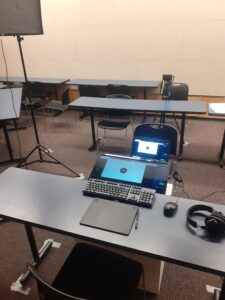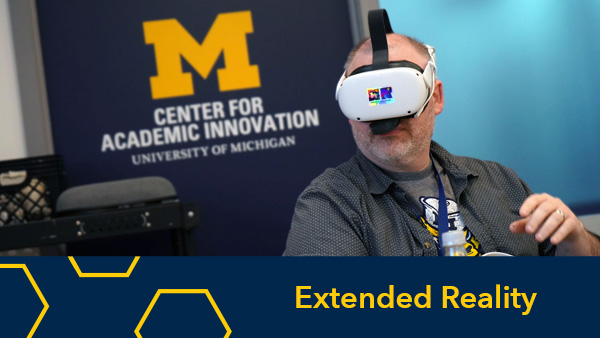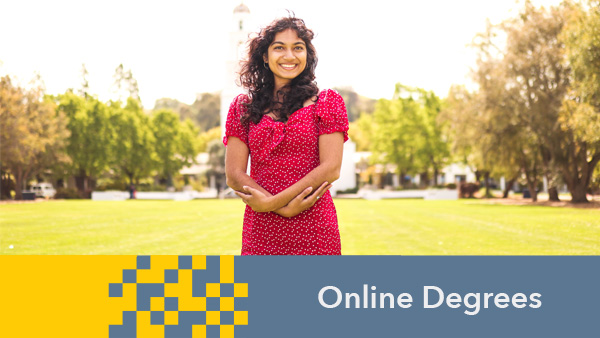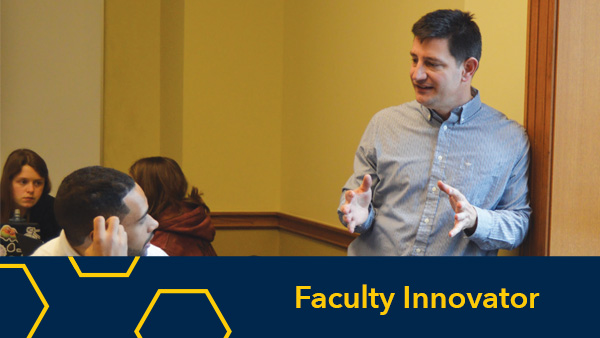Working with Center for Academic Innovation staff, Wilcox secured equipment to film lectures, record voice overs and create makeshift studio in his classroom
Parnia Mazhar, Communications Student Fellow
After two years in development, the day had finally arrived for Associate Architecture Professor Glenn Wilcox to begin production on his new online course. Then outbreaks of COVID-19 emerged throughout the country and everything shut down.
In an instant, he no longer had access to the Center for Academic Innovation filming studio, an in-person production team, or professional filming equipment. What he did have, however, was the motivation to keep pushing forward, and a team willing to help him. At this point, he had no interest in slowing down.
Every day for 30 days, Wilcox went into a classroom in the Taubman College of Architecture and Urban Planning where he set up his own one-person production studio and filmed content for his online course, Design Computing: 3D Modeling in Rhinoceros with Python Rhinoscript. With the help of Center for Academic Innovation Media Designer Alex Hancook and other center staff members, Wilcox worked to create content with the same high production value, but with a production team all working remotely.
Enroll Now | Design Computing: 3D Modeling in Rhinoceros with Python Rhinoscript
“When I first found out about quarantine and not being able to produce the course as we intended to, I was really disappointed,” Wilcox said. “But I don’t think it took me that long to think, ‘Well, we just have to find a way to move ahead with it. We’ve done all this preparation, so I’m ready to go and start recording stuff. Let’s figure something out.’ ”
Wilcox’s course initially consisted of three different presentation formats: filming himself lecturing while annotating a PowerPoint, filming himself using lightboard technology on a blackboard, and filming a software tutorial through screen capture and voiceover.

Because of the lack of technology and studio space at his disposal during quarantine, Wilcox and the team were forced to get creative. He filmed his voiceovers from home, but because his family also spent significant time on Zoom calls throughout the house, the only place that was quiet enough for him to record was the master bedroom. As a result, Wilcox created an office in his bedroom and built a desk and place to work. He then spent time securing a quality headset with the needed hardware and connection capabilities.
“There were some rough moments during this process, particularly when I was having technical problems with my computer,” Wilcox said. “I’d be ready to record something, and I would think I was recording it, and then it wouldn’t want to record the audio or something, and then I’d have to do it all over again. And that, like anything, was frustrating. But there was a motivation at that point that we had done so much work, so I just wanted to keep going and get it done.”
He also created his own makeshift recording studio in a classroom at Taubman, using his video camera and loaned production equipment from the center. Working with Hancook, he spent more than a week devising an appropriate setup, making sure his computer, the lighting, and the recording levels were all optimal.
“It was difficult, in a sense, being in charge of the technology, because I’d have to come in and sort of wear my ‘tech hat’ and get everything set up, and then do a couple lectures,” Wilcox said. “And that took probably a month of me working every day to record everything, because I could only do three or four lectures each day.”
Despite the challenges the remote production process presented, Wilcox said having help from the center, including Senior Learning Experience Designer Chelsea Chandler, greatly motivated him to continue pushing forward and gave him clarity on how to organize aspects of his course – like the assessments – for the learners.
“I think people like Chelsea had a very kind of light touch in how she motivated me to look at very specific things within the course and how I was teaching it,” Wilcox said. “And I mean, just the whole issue of assessment … there would have been no way I could have put that together without them.”
Wilcox found it quite helpful to have weekly meetings with center staff members to talk about content progress and new ideas, and have someone help with scheduling and take notes to keep everything on track.

“You’re really working in a team which was very interesting for me,” Wilcox said. “I’ve never had a team work on my course with me. So getting all these outside viewpoints from the team, being able to bounce ideas off of them, and really feeling like everybody wants to make a good course was a great experience. … I think they do a tremendous job.”
The help of media designers also added a new level of creativity to his course. For instance, Hancook had an idea to composite – or combine images into a single picture – Wilcox’s sketching alongside footage of him lecturing.
“It had a really nice effect,” Wilcox said. “It’s pretty effective because it was compositing me describing something, but also annotating it or drawing it at the same time.”
Wilcox’s Design Computing course is designed to show learners Python code in terms of its rules and syntax, and teach them what can be done with Python in its application and design. By the end of the course, learners should not only know the fundamentals of Python and Rhino script, but also understand them through the lens of their application in geometrically focused design lessons and exercises.
“I hope the course introduces learners to a world of technology and design that might have been inaccessible to them before,” Wilcox said. “When I was learning this information, there wasn’t any format in which it was really methodically taught; you had a lot of fragmented things that you had to put together from a bunch of different sources. And so that’s why I wanted to put together the course. I hope people appreciate that and recognize it, and that it would inspire them to to pursue coding further.”


